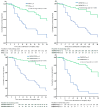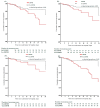Thrombosis and Bleeding Risk Scores Are Strongly Associated with Mortality in Hospitalized Patients with COVID-19: A Multicenter Cohort Study
- PMID: 38592277
- PMCID: PMC10932358
- DOI: 10.3390/jcm13051437
Thrombosis and Bleeding Risk Scores Are Strongly Associated with Mortality in Hospitalized Patients with COVID-19: A Multicenter Cohort Study
Abstract
Background: Internationally established guidelines mention pharmacological prophylaxis for all hospitalized COVID-19 patients. However, there are concerns regarding the efficacy and safety of anticoagulants. This study investigated the associations between thrombosis/bleeding risk scores and clinical outcomes. Methods: We conducted a retrospective review of adult patients admitted to two hospitals between 2021 and 2022. We analyzed clinical data, laboratory results, low molecular weight heparin (LMWH) use, thrombosis, bleeding, and 30-day survival. Results: Of the 160 patients, 69.4% were female, and the median age was 59 years. The rates of thrombotic complications and mortality were 12.5% and 36.3%, respectively. LMWH prophylaxis was administered to 73 of the patients (45.6%). The patients with high Padua prediction scores (PPS) and high IMPROVEVTE scores had a significantly higher risk of venous thromboembolism (VTE) compared to those with low scores (30.8% vs. 9.0%, p = 0.006 and 25.6% vs. 7.7%, p = 0.006). Similarly, elevated IMPROVEVTE and IMPROVEBRS scores were associated with increased mortality (hazard ratios of 7.49 and 6.27, respectively; p < 0.001). Interestingly, LMWH use was not associated with a decreased incidence of VTE when stratified by risk groups. Conclusions: this study suggests that COVID-19 patients with high thrombosis and bleeding risk scores have a higher mortality rate.
Keywords: COVID-19; IMPROVE score; Padua prediction score; mortality; venous thromboembolism.
Conflict of interest statement
The authors declare that this research was conducted in the absence of any commercial or financial relationships that could be construed as potential conflicts of interest.
Figures





References
-
- Demelo-Rodriguez P., Farfan-Sedano A.I., Pedrajas J.M., Llamas P., Siguenza P., Jaras M.J., Quintana-Diaz M., Fernandez-Capitan C., Bikdeli B., Jimenez D., et al. Bleeding risk in hospitalized patients with COVID-19 receiving intermediate- or therapeutic doses of thromboprophylaxis. J. Thromb. Haemost. 2021;19:1981–1989. doi: 10.1111/jth.15400. - DOI - PMC - PubMed
Grants and funding
LinkOut - more resources
Full Text Sources
Medical

